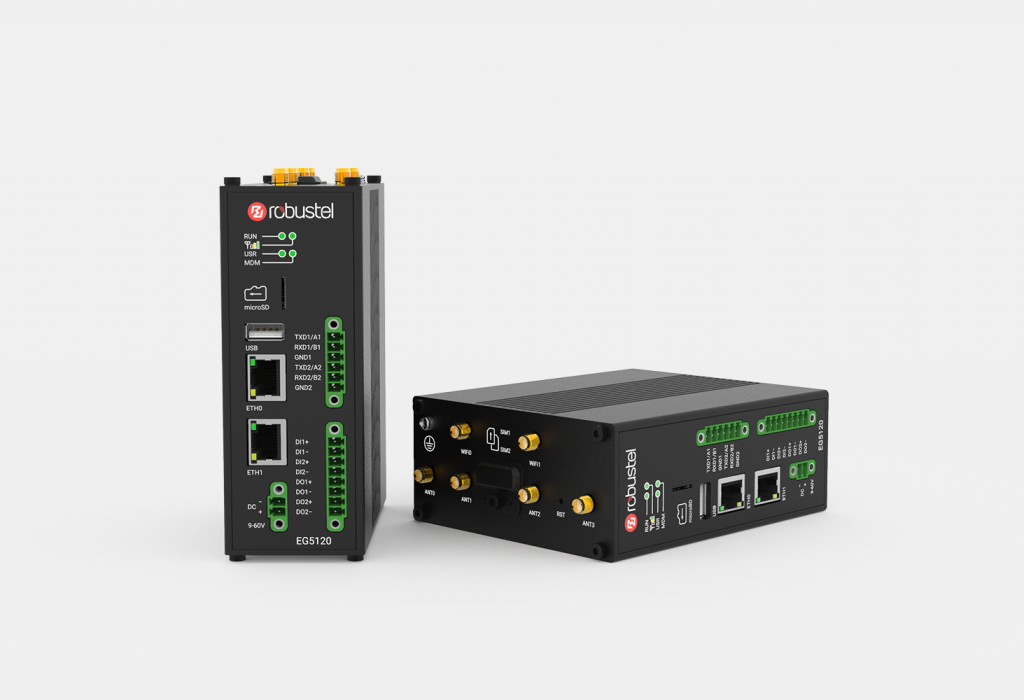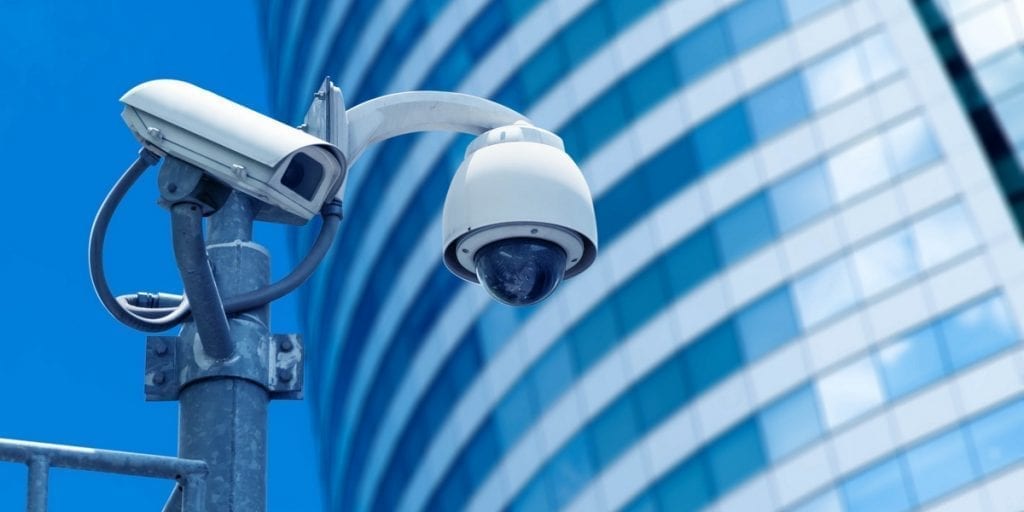At the time of writing this blog post (July 2022) the latest GSMA Intelligence report lists 198 commercial 5G launches worldwide, with roughly 9% market penetration. With the lofty prediction of 1.2 billion, or 26% of global connections being 5G primary by 2025. Has the hype finally moved to reality? The answer is yes, but with a lot of caveats.
Robustel launched our flagship 5G device the R5020 at the tail end of 2020, and over the course of 2021 we’ve seen hundreds of experiments and proof of concept use cases come and go.
With the launch of our next generation 5G router the EG5120 on the horizon, we thought now was a great time to reflect on some of the use cases we’ve seen over the past year, and where we are seeing the most uptake of 5G technology.

Robustel EG5120 - 3GPP R16 NR Edge Computing Gateway
5G - the need for a ‘fatter pipe’
At the end of the day a lot of use cases we have seen for 5G rely on the simple premise that you can push more data faster over the mobile network than traditional 3G/4G use cases. Which makes sense as we saw the exact same trend when going from 2G to 3G, and 3G to 4G/LTE.
This opens up 5G as a viable alternative for enterprise networking solutions like ADSL/Broadband failover, and even as a rapidly deployable primary connection (which doesn’t necessarily qualify as an IoT solution).
However, it’s important to mention that with a 5G connection as ‘a fatter pipe’ you can run multiple connected systems off a single router with minimal headaches. This makes applications in retail, point of sale and digital signage very attractive, which can lead into more traditional IoT-type deployments.

1. Public Wi-Fi Connectivity
Ok… So we cheated a bit - even though we prefaced this list by talking about enterprise connectivity not really being ‘IoT’, it’s impossible to ignore the massive prevalence of 5G routers being ordered and used to provide Wi-Fi Connectivity to the public. This includes:
- Trains
- Buses
- Ships
- Airports
- Sports Grounds
- Shopping Malls
- Public Spaces
The list goes on and on. Anywhere people want to connect providers are considering 5G as the Wi-Fi solution of choice.
Where this becomes interesting is the ability to partition and manage 5G connectivity at a router level. Suddenly the need to quarantine backend systems (like telematics, payment services and monitoring solutions) on a separate router to public traffic is eliminated. The speeds provided by 5G make it perfectly viable to offer consumers Wi-Fi solutions while also running IoT systems on the same network, through the same router, saving considerable cost and opening potential big data possibilities.
Of course, we’d be remiss if we didn’t remind you that while the cost-saving of load balancing on a single router can be attractive, if you are mixing public and private connectivity you need to make sure you are comfortable with network security.
2. Intelligent Transport Systems
While 5G presents exciting broadscale applications for ‘Smart Cities’, where we’ve been seeing a lot of proof-of-concept solutions become reality are in Intelligent Transport Systems (ITS).
As the global population increases, the need for cities to expand outwards as well as upwards is becoming very real. With outward expansion, the need for new road and traffic infrastructure grows. Previously, one of the major issues for new traffic management solutions was endless amounts of cabling for traffic lights, speed cameras, etc.
This can all now be covered with LTE/4G technology.
Where 5G really starts to come into its own is the speed at which data can be sent from a remote location to the cloud. For example, using a mixture of sensors, cameras and AI, road authorities can get crystal clear video to an operation centre the moment a crash occurs.
Then - using the same network - they can begin remotely diverting traffic, adjusting speed limits and deploying warning signals, all while using the analytic data from the crash site to know the extent of personnel and equipment needed to efficiently manage the situation.
3. Unmanned/Autonomous Vehicles
Put away your thoughts of Westworld and driverless cars everywhere for now, we’re not talking about that kind of Autonomous Vehicle (although 5G definitely helps bring us closer!).
No, what we’re talking about are vehicles used on private land. This can include small robots inside a factory zipping about and stocking/picking shelves, all the way up to huge mining equipment, rolling around sites that can easily span several kilometres.
Using a 5G network for communications means factory robots can report back and be sent commands in virtual real-time without being weighed down with burdensome processing capabilities for edge-based decision making. This makes the robots cheaper and more battery efficient in the long-term.
5G is being used in mine sites for safety and operational efficiencies, while private 5G networks are deployed to run autonomous machinery 24/7, in areas that would require significant safety precautions for human staff. The other safety benefit of 5G use with autonomous vehicles in mining again comes from the ability for decisions to be made in real-time thanks to low latency connections. This means cameras and sensors can be mounted on vehicles to notify workers or supervisors of potential collisions and accidents.

4. Mass data processing
Lower latency and higher speeds mean the ability to draw data from more datapoints into a central cloud location for processing. This lends itself to applications that use massive amounts of data to provide actionable insights. Some examples of these might include people-counting and heat-mapping devices in shopping centres or public events, to life-saving applications like streaming patient health data from a moving ambulance on its way to a hospital.
This is where 5G and Fog/Edge computing can simultaneously compete and complement each other. For example, the high speeds and low latency benefits of 5G mean you could in theory put a relatively ‘dumb’ router at a location and just stream endless waves of data to a central cloud server, where the processing can be done on a massive scale by data centres. Alternatively by combining Edge processing and 5G speeds (like those offered in the EG5120) IoT devices on the network edge can make decisions on what data to send immediately and what to archive, making a much more efficient use of the network and resources.

5. IP Cameras
The final ‘real-world’ application for use with the R5020 that has seen a huge amount of demand is IP Cameras. Leaning into the ‘fatter pipe’ analogy, being able to stream high-definition video in real-time over the mobile network has limitless potential in security, safety, and emergency services.
With older technologies like 3G (and even 4G/LTE) a lot of camera applications had to be event driven, often taking static images or short video at the moment of an incident, then processing and sending to a monitoring location, which made any real-time application difficult.
However with 5G technology video can be streamed constantly. We’ve seen applications where streaming is kept purposefully to a low resolution to reduce bandwidth usage, and then bumped up to 1080p or 4K the moment an incident is detected.
5G technology allows cameras to become remote eyes and ears for security and public safety applications, with data feeds coming in high-quality in real-time, allowing operators on the other end to make split-second decisions that can save lives.
Conclusion
In conclusion 5G for IoT has arrived and we’re finally seeing use cases move beyond the theoretical and into mass production. As the price of 5G componentry reduces and networks start to introduce ‘slicing’, we imagine the prevalence of 5G in IoT will exponentially grow. With global 3G shutdowns continuing to roll-out, customers are already starting to ask if they can ‘leapfrog’ 4G/LTE and go straight to 5G.
If you’d like to learn more about 5G technology and Robustel’s solutions – Please feel free to reach out to us at info@robustel.com and we can put you in touch with one of our global IoT specialists or regional partners.
